Choosing the right color for the roof in relation to the facade is a whole science. First, you need to decide how the desired colors should match the choice. Should they blend in with the surrounding area, or vice versa, the house will stand out with its bright colors. In any case, it is recommended to adhere to some decorating rules. Observance of all the subtleties when choosing will allow, at low cost, to give the house a unique and bright style.
How to choose the right color scheme
You need to know that the shade of the outer walls of the building is of decisive importance in choosing the color of the roof. It is recommended to use bright saturated colors on roofs with simple surface geometry and a minimum amount of decorative elements. Otherwise, visual perception will be difficult. A dark roof covering attracts significantly more rays, resulting in more heat. In addition, under the influence of the sun, dark coatings fade more. For this reason, preference should be given to quality materials that will save on future costs.
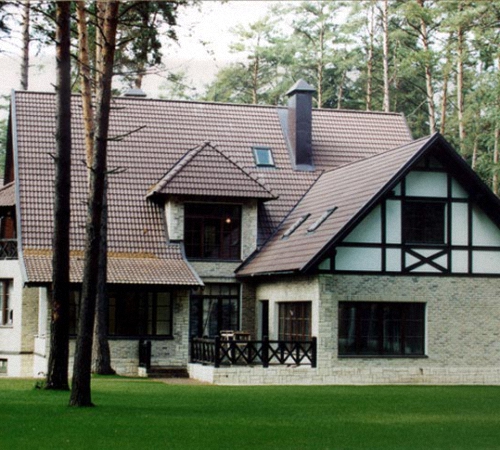
If the house is surrounded by trees, then there is often advice to choose light shades of the facade and roof colors. In this case, falling autumn leaves on the roof are not so noticeable. In addition, the shadow from the trees will be visually more noticeable, which will give the final style a complete look. Bright red or black materials are best used in detail without giving the chosen color a dominant position. There are several selectable directions when choosing the color of the facade and roof:
- a red roof is more suitable for painting walls in a light brown or gray tone,
- green roof color is combined with facades of light shades: white, gray, light yellow, cream,
- black color always sets off the overall color scheme, for this reason it is used to visually reduce the roof area,
- for a white plastered facade surface, a terracotta color is considered optimal. As a rule, this is a rich shade of red,
- the heavenly shades of the facade and roof merge with the sky, so this color selection is not recommended.
In any case, before deciding, you need to study all the proposals and dwell on a less intense shade.
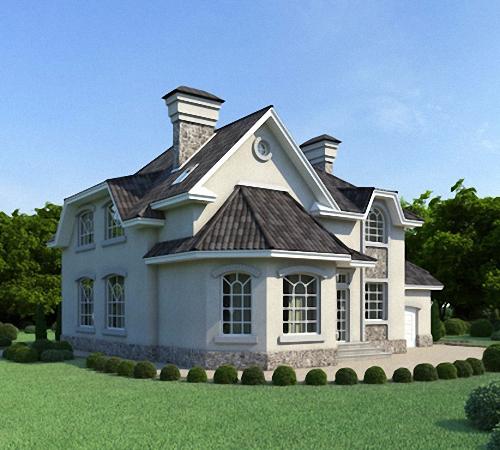
What factors influence the choice?
The combination of colors of the roof and facade initially requires taking into account the peculiarities of the location of the house in relation to the terrain. There are some tips to help you with counting the area:
- Houses that are located in the northern regions are often made with a darker roof.

When exposed to sunlight, the dark color absorbs more UV radiation, which causes the roof to heat up more. However, the heat output is also greater - which will be its advantage in the cold season. This effect is especially pronounced on the roof of corrugated board and metal tiles.
- If tall plants are planted near the house, then a combination of natural shades: brown and green is recommended. By analogy with the close location near water bodies, the color scheme of heavenly and beige colors is more often used.
- The selection of the color of the roof should be based on compliance with the architectural style of the building. For example, the classic style of the building does not accept bright colors, while soft pastels and chocolate-cinnamon tones will give such a house a beautiful and complete look.

- A well-chosen color of the facade and roof can hide the architectural flaws of the structure, while emphasizing its advantages.
- If the building has a complex architectural shape, then it is not recommended to use bright colors for the main color scheme. In this case, all bends and complex shapes will become unnecessarily highlighted on a common basis. Therefore, in this case, it is advisable to resort to calm light shades with darker frames for windows and doors.
- The chimney is often clad in accordance with the chosen color and the material that is used for the roof. Choosing a different color can disrupt the overall composition.
As a rule, two primary colors are used in the design of the appearance of the facade and roof. Sometimes a third is mixed with them, as a separate color for the design of facade elements.
Matching color to match
Choosing a color scheme is a difficult question for non-specialists. In this case, it makes sense to either contact the graphic designer, or use the data from the table below: 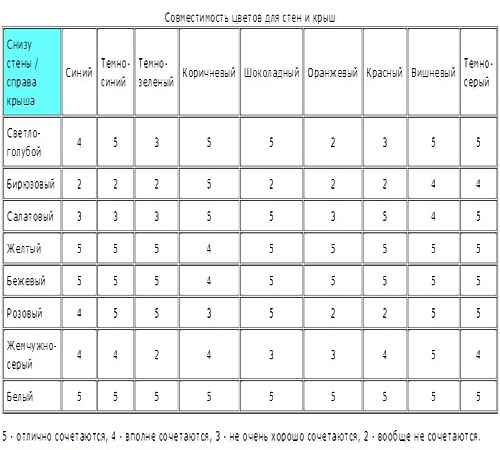
The filing of overhangs and downpipes are selected to match the color of the roof, while it is allowed to use a color scheme that is in harmony with the color of the facade. The schemes themselves for combining the color of the roof and facade of the building are divided into several varieties:
- traditional dark top / light bottom scheme. The most widespread conservative style
- option “dark walls / light roofs”. It is rarely used, but such a scheme is interesting for the effect of merging with clouds,
- the design of the roof and facade in a single color allows the building to acquire a monolithic and harmonious look. Some designers criticize this scheme, calling it "boring". It is useful to note that the design of the wall and roof in one color, and the border elements in another, significantly diversifies the style. Such elements include window sills, doorways and roof skirts, together with downpipes,
- if the area where the house is located is well open and is illuminated from all sides by the sun, then it makes sense to think about the gray scale of the design. Despite some nondescriptness, gray is considered one of the most practical. It does not fade in the sun; over time, yellow spots do not form on it, as on white. If, when using gray shades, you use a resonant dark color to frame some elements, you will end up with a beautiful-looking design.
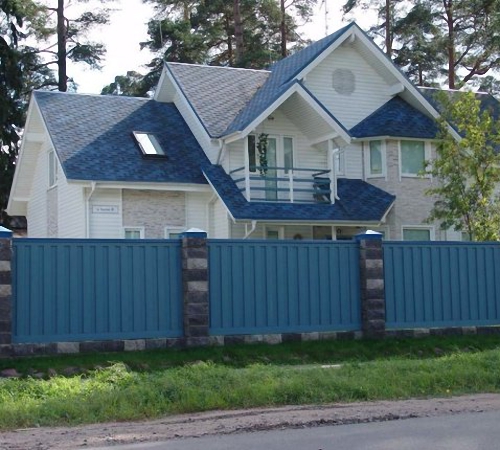
The choice of the range depending on the style of construction
Architecture requires taking into account the peculiarities of the design and arrangement of elements on the facade and roof of the building. And there are recommendations for each style:
- the classic style requires strict adherence to the balance of colors. One color scheme is used, usually light pastel colors. It is necessary to ensure a smooth transition from one color to another. At the same time, it is unacceptable to design colors on the contrasts. Details on the walls should be set off from the general background of the wall. For example, columns, arches and stucco on the walls should have a different shade than the general facade of the building,
- the Romanesque style requires execution in tonalities that imitate the color of natural stone. In this case, individual elements are highlighted with a darker scale, the main color is the same. The Romanesque style involves the use of roof tiles. It is recommended to partially cover the walls with mosaics,
- the gothic style remains popular with antiquity devotees. It implies the use of sharp architectural forms, while the color of the roof and facade is often noticeably different from each other. Architectural compositions of the Gothic style are rather difficult to build, so they are almost never found in country houses. Few mansion owners are able to afford this,
- romantic historicism allows you to combine different opposite colors. As a rule, the facade is matched to the natural color of stone or brick, while the roof often has a rich blue or green color. Green shades are used under a white or beige facade, blue or burgundy - under gray masonry,
- Renaissance style demonstrates simplicity and sophistication. It does not tolerate cold gray shades and is based on warmth. Therefore, the color of the facade and roof is selected either in reddish or in a creamy brown color scheme,
- the respectability of the owner of the house shows a commitment to the Baroque style. This trend is distinguished by a love of light colors, while omitting bright colors. Baroque is characterized by a significant number of details in architecture, therefore, neutral shades of the facade and roof will harmoniously fit them into the overall style,
- a bold step towards the modern era demonstrates the functional style of classicism. The color of the facade and roof assumes a single neutral style in a monochromatic range of white or cream style,
- minimalism style looks spectacular with a combination of white and steel colors. Allows the use of one bright element, while the correct combination of shades can completely transform the unassuming appearance of the building,
- adherents of the Alpine style of decoration prefer to match the color of the facade to the main element - wood. A large number of wooden elements require a careful selection of colors. The main color when choosing is white and beige,
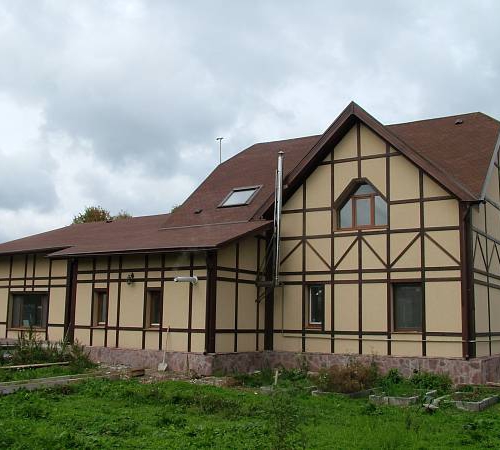
- chalet style implies an abundance of stone combined with wood. In this case, the color emphasis is on the design. The chalet assumes an abundance of chocolate shades and thanks to this, even a small country house will acquire a spectacular style,
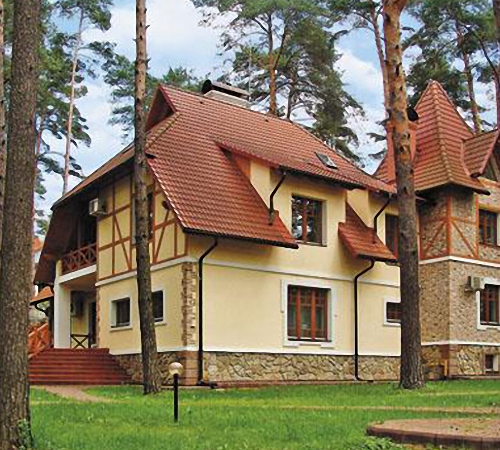
- ethnic style is selected depending on the preference of the owner of the building. There are a significant number of design options, and it is necessary to adhere to the traditions in the design.
In fact, each style has its own appeal and, importantly, most of them are quite capable of implementing in your country house.
Color matching for siding and roofing
Siding is a cladding element that has found frequent use in the decoration of new and old buildings. There are several varieties of it, but due to its characteristics, it was vinyl that gained popularity. Such varieties are made from polyvinyl chloride using the extrusion method. This is understood to mean the extrusion of the polymer mass through the forming nozzle. The PVC panels obtained in this way are distinguished by their strength and elasticity, while being able to withstand accidental impacts. Just as in the case of other facade finishing options, siding facade cladding involves several traditional solutions:
- a light facade and a dark roof are pleasing to the eye, as they contrast well with the roof in terms of color,
- using the same tonality when choosing a facade and roof looks harmonious, but a little boring,
- a light roof and a dark facade are excellent design innovations, but require a more careful selection of colors,
The roof and facade made in different colors will be an excellent solution. In particular, natural colors are well suited for aesthetics. It should be remembered that there are several subtleties that negatively affect the aesthetics of the appearance of the building:
- the use of contrasting shades can negatively affect the final style,
- the monochromatic range will look somewhat boring,
- vinyl siding coverings are often brightly colored. Moreover, their use as the main decorative elements is impractical. Natural colors look better as the main color,
- the variety of different colors for facade decoration will negatively affect the overall perception. Therefore, it is not necessary to use more than three color schemes when choosing the color of the facade and roof.
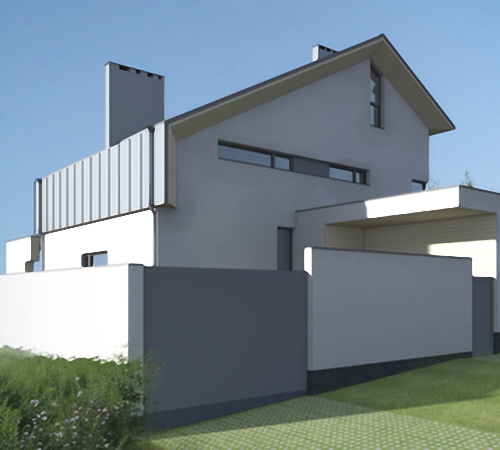
It is not so difficult to carry out the correct selection of the color scheme. Thanks to the availability of recommendations, advice from experts and even online services for a selection of color schemes, it is quite possible to imagine the future style of your country house.




